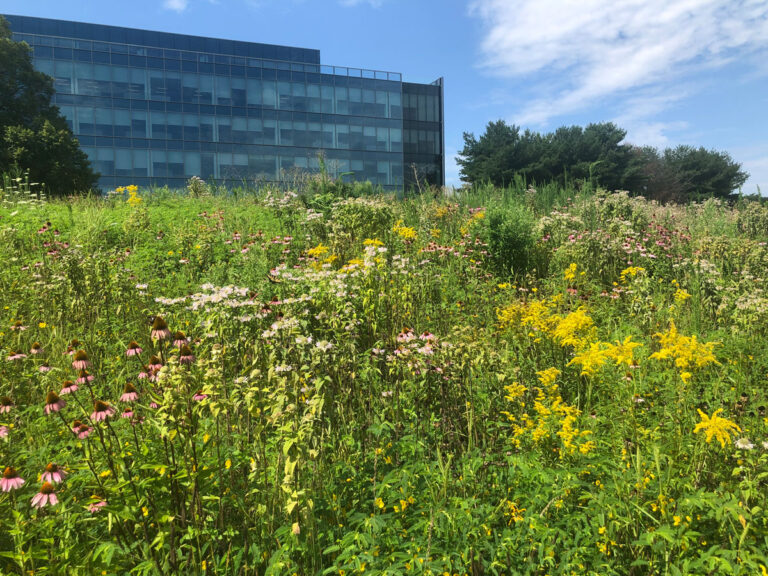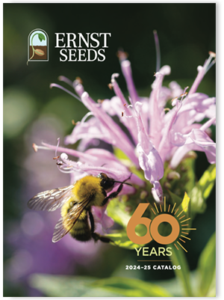Envisioning the Possibilities for Pollinators
In 2015, when the McCormick Corporation announced that they would break ground on their new headquarters in Hunt Valley, Maryland, they saw 350,000 square feet of possibilities. They planned on offering amenities like a full-service café and a fitness center, which spoke to their company’s desire to create an inviting workplace for their staff of almost 1,000 people. But McCormick’s leadership also wanted to reinforce their company’s commitment to sustainability by going beyond the typical few acres of lawn when it came to green space: a pollinator meadow.
Landscape architect Alice Sturm worked on the project during her time at Mahan Rykeil Associates.
“With a client of this scale, it was so important to ensure there was a thorough, iterative design process,” she said. “This was a prominent site in front of a major corporate headquarters, so we needed to balance aesthetics and communicate their corporate values about sustainability.”
The project site was a previously undeveloped area of warehouses with sparse natural resources beyond some preserved trees around its perimeter. As the team assessed the logistics, they wondered if they could truly create a thriving pollinator habitat.
As Sturm recalled, “We were asking ourselves: Are there actually going to be pollinators there, or is this just greenwashing?”
Taking an Inventory of Existing Ecological Quality
As the project team planned the new meadow installation, the nature of the site posed one of the biggest hurdles.
“Because the area is dominated by warehouses and retail, these shopping sites likely don’t use native plants and may use pesticides,” Sturm said.
An industrial area lacking in natural resources could prove challenging for pollinators like bees to find and thrive in. But, if the project succeeded, a well-established meadow could serve as a much-needed habitat for local pollinators who had been squeezed out by industrial development in the area.

Building a Pollinator Meadow From the Ground Up
In the beginning stages of the meadow installation in 2016, the team set out with an open mind as to which pollinators they could attract. But, as a local, Sturm hoped to see certain species common in the area, like sweat bees and monarch butterflies.
When it came time to select a mix to seed the meadow with, Sturm and her colleagues searched for a native seed mix that would allow for high bloom density, high plant diversity and, of course, a beautiful visual profile.
Sturm had partnered with Ernst Seeds on several successful projects throughout the mid-Atlantic and knew to turn to them for guidance on finding the best native seed mix.
“I have worked a lot with Ernst,” said Sturm. “They’re just by far the main, but also the best, seed purveyor in the region. They’ve got so many great off-the-shelf mixes.”
The Showy Northeast Native Wildflower and Grass mix was ideal for the McCormick meadow project, containing a beautiful array of species like milkweed to attract butterflies.
“We wanted a high density of blooms, partially to communicate the site was intentional,” she said. “We didn’t want it to look like a lawn someone forgot to mow, and a high bloom density really helps get that point across.”
The meadow was seeded in two rounds, each a year apart. On Ernst’s recommendation, the team used a cover (or nurse) crop, intended to help establish and protect perennial plants. Knowing that many species in a meadow take two or more years to flourish, the team was sure to communicate early and often with McCormick to manage their expectations as the meadow began to come to life. Sturm and the project team also prepared their client with information on how to best maintain the meadow once it was established.
Inviting Pollinators Back Home
To measure the success of the meadow as a pollinator habitat, Sturm and her firm partnered with the Xerces Society for Invertebrate Conservation. Their study, funded by a small grant from Penn State University, comprised four site visits throughout 2019 to compare the plants established in the meadow to the plants in the seed mix.

The team measured plant frequency via a nested quadrat method, based on the known dormancy level of the plant and how many seeds were put down. Wanting to avoid killing any of the area’s bees, which is typically required in a species-level identification study, the team instead opted to count pollinators through an observatory method, recording data from every insect or animal seen visiting a flower in the same transect for the same amount of time.
What the study uncovered was a thriving ecosystem, teeming with native bumblebees, monarch and swallowtail butterflies, dragonflies, ladybugs, praying mantises and more.
“The meadow has maintained diversity now for several years, which is always something you’re concerned about with seeded meadows,” said Sturm. “It has been so exciting to see the diversity of blooms available to pollinators throughout the season. It is really full of life.”
Creating a Stir in the Company and Community
Years later, the meadow serves as a strong reminder of what is possible when companies commit to living their sustainability missions. Beyond bees and dragonflies who make their home in the area, McCormick staff also enjoy a nearby walking path to decompress and reconnect with nature.

“McCormick, being a global company, really embraced that global perspective of ‘pollinators are important worldwide,’” said Sturm. “Throughout this project, the primary unknown was whether this site would be purely an aesthetic signaling that there were pollinators in the area, or if there would actually be pollinators. The great news is that it’s turned out to be both.”
Developing a pollinator meadow that meets sustainability missions will require careful seed selection to bring your concept to life. Contact Ernst Seeds for more information about our native seed mixes.


